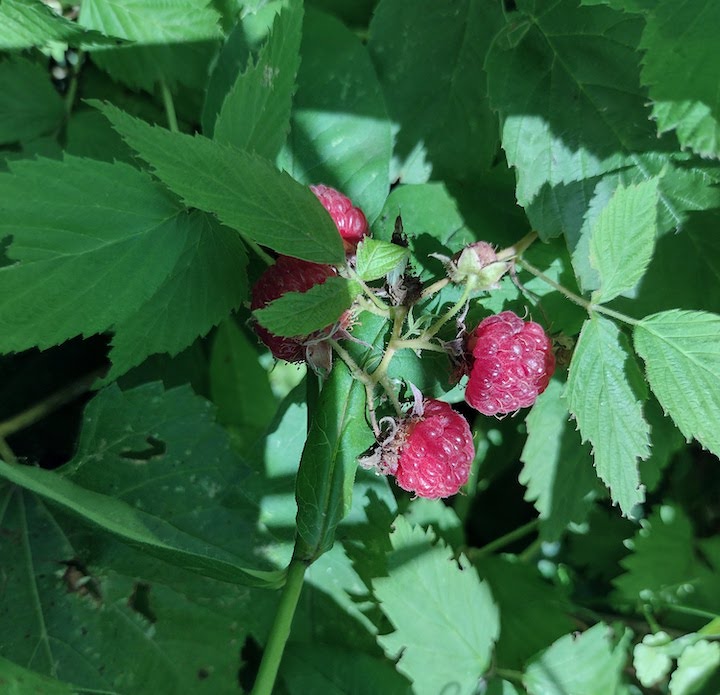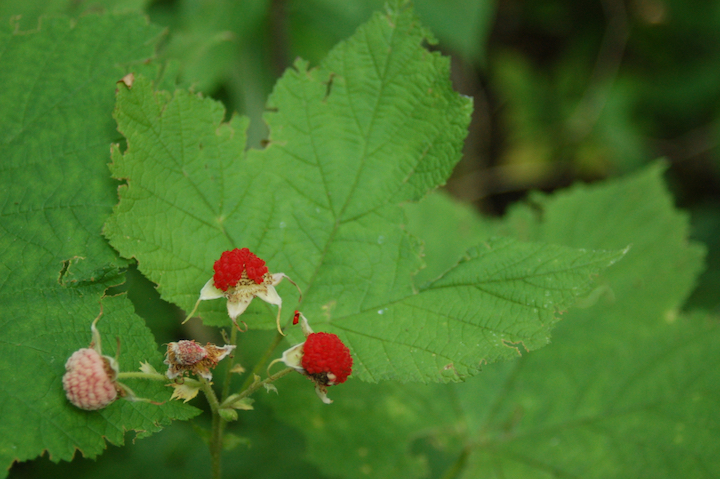The wild edible berries we cover here are found in the Midwest of the US, since that’s where I live.
There are many others, too, but this will get you going on some great snacking options when hiking and camping.

Edible wild berries are wonderful to add to cereal, yogurt, pancakes and desserts. If you know where to pick and bring containers with you, you can even pick enough for a pie.
Or just pick and enjoy as you go…unless you’re in national parks or state parks. Better check the rules first!
The thing to know if you’ve not picked wild berries before: they’re much smaller—and usually tastier—than their domesticated cousins.
Here are seven wild berries that are edible:
1. Blueberry
Blueberries grow wild all across the colder parts of North America. These small, compact bushes love sun, love rocky soil, and—we found after hitting the jackpot in a few spots—they seem to love the ashy post-forest fire soil.

Blueberries grow in clusters, as you can see in the photo above. There’s nothing quite as wonderful as stumbling upon a blueberry patch when you’re hiking, or on a portage during a canoe trip!
Serious blueberry pickers have a reputation for being very secretive and protective of their favorite spots. So if you question any of these folks, don’t be surprised by their evasive answers!
Depending on how far north you are, blueberries ripen mid-summer into late summer. You know they’re ripe when they’re a brilliant blue. Unripe berries are whitish to light purple (you can see the difference in the above photo).
NOTE: Not all blue berries are blueberries, so know what to look for. Look for the distinct “crown.” At least in northern Minnesota, there are blue berries that are toxic!
2. Bunchberry
I’m only including these because they’re edible, as in not toxic. I’ve not eaten them myself because I’ve heard they’re not very tasty. They sure look vibrant on their squat little plants, though! And if you’re ever in a tight spot and need to eat to survive, they’ll help you out.

Bunchberry plants have the prettiest little 4-pointed white flower in mid-to-late spring (Go to Minnesota Wildflowers and scroll down to Bunchberry). They grow on 5-6 inch plants in shady woodlands, often in large patches.
3. Raspberry
Like blueberries, everyone’s heard of raspberries. These common berries are tangy sweet and just as delicious in pancakes as blueberries are!

They grow on bushes that are often waist-high in areas with plenty of sun. Since the berries hang from their stalks below the leaves, be sure to lift up the branches to find them all. You’ll know they’re ripe when they’re bright red.
4. Saskatoon Berries
Saskatoon berries (also known as serviceberries and June berries) grow on bushes that can be just a few feet tall up to tree-size, depending on the variety.

They seem to like the same areas as blueberries, as we’ve seen them together. The berries are about the same size as blueberries, too.
They start out red and gradually deepen to dark purple when they’re ripe. Super tasty! They’re a little sweeter than blueberries.
The best way to differentiate it from similar-looking berries is by its crown—very similar to blueberries.
5. Strawberry
Wild strawberries are a miniature version of their domesticated cousins. Tiny and super flavorful, they make wonderful jam if you can find enough of them!

They grow on tiny 3-leafed plants that are just a few inches tall, and love the sun. The berries hang down so they can be hard to spot unless you lift the leaves up. They ripen in mid-to-late spring, earlier than most of the other berries on this list.
6. Thimbleberry
Thimbleberries look sort of like raspberries except they grow up above their leaves instead of hanging down on the short stalks.

The leaves are huge, as seen in the photo above, and look like maple leaves. I’ve heard they make good TP in a pinch since they’re soft, too! (No personal experience with that yet.) They’re shady woodland dwellers on plants up to 3 feet tall.
The berries aren’t quite as flavorful as raspberries, nor are they as plentiful on each plant. But they’re easy to spot and grab, and still very tasty. They start almost white and deepen to bright red when ripe, in mid-late summer.
7. Wintergreen Berry
The bright red berries of the tiny wintergreen plant are edible. As its name suggests, the wintergreen’s leaves stay green throughout the winter, and the berries stay on the plant into spring.

(I’ve not personally eaten these so can’t vouch for the flavor.)
The waxy leaves of this little plant have been used for centuries in tea and medicinally. They grow and spread in wooded areas.
We love camping during blueberry season in northern Minnesota. We bring containers along with us on our hikes in areas known for berries so we can pick a few for pancakes.
What a wonderful treat!

There are many field guides available about wild berries where you live, like this one. Search your favorite bookstore!
Here’s more…
- 11 Wonderful Things in Our Natural World - February 6, 2025
- What Kind of Exercise Is Best? - January 10, 2025
- 116 Verses in the Bible that Talk About Light - December 10, 2024
